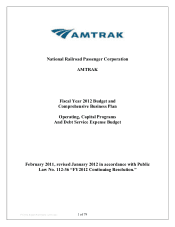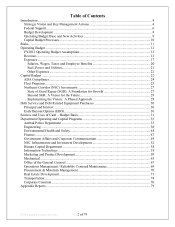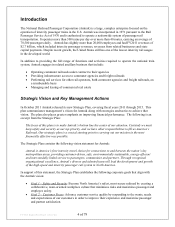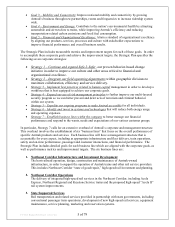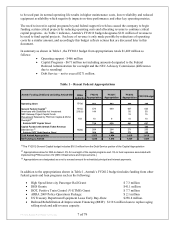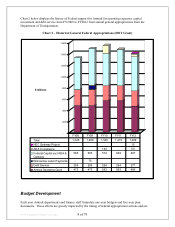Amtrak 2012 Annual Report Download - page 11
Download and view the complete annual report
Please find page 11 of the 2012 Amtrak annual report below. You can navigate through the pages in the report by either clicking on the pages listed below, or by using the keyword search tool below to find specific information within the annual report.
Project Scope – A description of what the project is and the intended purpose/objective of the
project.
Project Justification – An explanation of why the project is necessary and how performance will
be measured.
Funding Sources – The assumed source of funds that will pay for the project.
National Environmental Policy Act (NEPA) Codes – Codes that describe the status of
environmental impact of a project.
Project Phases – The capital planning process requires that costs be budgeted by phases. This
information is required to conduct a Generally Accepted Accounting Principles (GAAP) review
of the projects.
Return on Investment Analyzer – The submissions included an analysis estimating the return on a
capital investment. All projects that claim business improvement benefits were required to have
this analysis completed; state of good repair programs including rolling stock rehabilitation are
excluded.
Project Outcome and Performance Measures – The submission included a worksheet to input
outcomes and performance measures. This is a brief description of major outcome or outcomes
anticipated upon completion of the project, and the measurement.
A Capital Budget Appendix that contains Program and Project Summaries in this budget is available.
Risks
We must address the possibility that matters beyond our control may alter our current estimate of our
needs for capital and operating funding. The unsettled state of the economy and the fluctuations of fuel
prices are serious concerns. Fuel prices have been particularly volatile in recent years and the potential
for price increases poses a serious risk to the financial health of the company. Similarly, an economic
downturn, particularly in the Northeast Corridor region could lead to unfavorable results in ridership and
revenues. Budgetary issues faced by some of our state partners could likewise pressure our operating
budget needs. Risks that can impact Amtrak’ s operating and capital funding needs include:
If Amtrak does not receive sufficient Federal Government funding, Amtrak’ s ability to operate
in our current form may be adversely affected.
Amtrak’ s business is capital intensive, and without sufficient capital investment, Amtrak will
be unable to maintain and improve current infrastructure and rolling stock.
Instability or unavailability of Amtrak’ s information technology systems could have a
detrimental effect on Amtrak’ s business.
Legal proceedings may adversely affect Amtrak’ s business operations.
Amtrak’ s business is subject to numerous operational risks – such as changes in general
economic, weather or other conditions, equipment failure, disruption of its supply chain, war,
acts of terrorism and other catastrophic events – which could result in significant disruptions to
Amtrak’ s operations, increased expenses or decreased revenue.
Amtrak’ s costs and revenues could be substantially adversely or positively affected by
competition from airlines, buses and other modes of transportation.
Amtrak’ s business is vulnerable to rising fuel costs and disruptions in fuel supplies.
Amtrak's business is subject to federal, and to some state and local, laws and regulations.
Amtrak’ s business is subject to environmental laws and regulations that may result in
significant costs.
Most of Amtrak’ s employees are represented by unions, and failure to negotiate reasonable
collective bargaining agreements may result in strikes, work stoppages or substantially higher
ongoing labor costs.
Catastrophic events could result in liabilities exceeding Amtrak’ s insurance coverage.
FY2012 Budget Post Board 1.20.12.doc 11 of 79
Amtrak has a mature work force, with substantial employee retirements expected in upcoming
years, and therefore has large potential pension and other post-employment benefit obligations.

